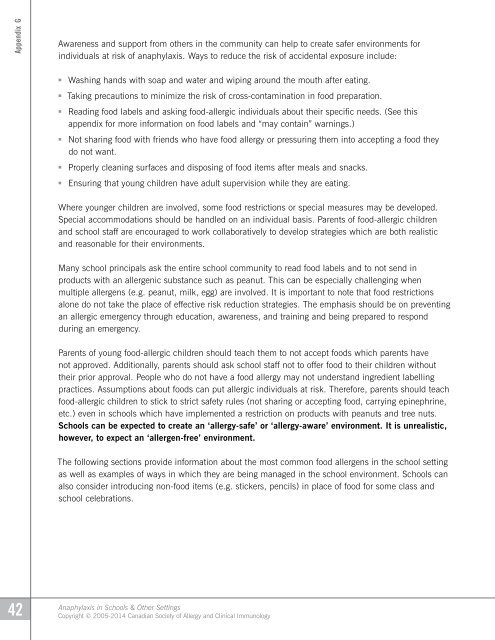Anaphylaxis in Schools 3rd Edition
Anaphylaxis in Schools 3rd Edition
Anaphylaxis in Schools 3rd Edition
You also want an ePaper? Increase the reach of your titles
YUMPU automatically turns print PDFs into web optimized ePapers that Google loves.
Appendix G<br />
Awareness and support from others <strong>in</strong> the community can help to create safer environments for<br />
<strong>in</strong>dividuals at risk of anaphylaxis. Ways to reduce the risk of accidental exposure <strong>in</strong>clude:<br />
• Wash<strong>in</strong>g hands with soap and water and wip<strong>in</strong>g around the mouth after eat<strong>in</strong>g.<br />
• Tak<strong>in</strong>g precautions to m<strong>in</strong>imize the risk of cross-contam<strong>in</strong>ation <strong>in</strong> food preparation.<br />
• Read<strong>in</strong>g food labels and ask<strong>in</strong>g food-allergic <strong>in</strong>dividuals about their specific needs. (See this<br />
appendix for more <strong>in</strong>formation on food labels and “may conta<strong>in</strong>” warn<strong>in</strong>gs.)<br />
• Not shar<strong>in</strong>g food with friends who have food allergy or pressur<strong>in</strong>g them <strong>in</strong>to accept<strong>in</strong>g a food they<br />
do not want.<br />
• Properly clean<strong>in</strong>g surfaces and dispos<strong>in</strong>g of food items after meals and snacks.<br />
• Ensur<strong>in</strong>g that young children have adult supervision while they are eat<strong>in</strong>g.<br />
Where younger children are <strong>in</strong>volved, some food restrictions or special measures may be developed.<br />
Special accommodations should be handled on an <strong>in</strong>dividual basis. Parents of food-allergic children<br />
and school staff are encouraged to work collaboratively to develop strategies which are both realistic<br />
and reasonable for their environments.<br />
Many school pr<strong>in</strong>cipals ask the entire school community to read food labels and to not send <strong>in</strong><br />
products with an allergenic substance such as peanut. This can be especially challeng<strong>in</strong>g when<br />
multiple allergens (e.g. peanut, milk, egg) are <strong>in</strong>volved. It is important to note that food restrictions<br />
alone do not take the place of effective risk reduction strategies. The emphasis should be on prevent<strong>in</strong>g<br />
an allergic emergency through education, awareness, and tra<strong>in</strong><strong>in</strong>g and be<strong>in</strong>g prepared to respond<br />
dur<strong>in</strong>g an emergency.<br />
Parents of young food-allergic children should teach them to not accept foods which parents have<br />
not approved. Additionally, parents should ask school staff not to offer food to their children without<br />
their prior approval. People who do not have a food allergy may not understand <strong>in</strong>gredient labell<strong>in</strong>g<br />
practices. Assumptions about foods can put allergic <strong>in</strong>dividuals at risk. Therefore, parents should teach<br />
food-allergic children to stick to strict safety rules (not shar<strong>in</strong>g or accept<strong>in</strong>g food, carry<strong>in</strong>g ep<strong>in</strong>ephr<strong>in</strong>e,<br />
etc.) even <strong>in</strong> schools which have implemented a restriction on products with peanuts and tree nuts.<br />
<strong>Schools</strong> can be expected to create an ‘allergy-safe’ or ‘allergy-aware’ environment. It is unrealistic,<br />
however, to expect an ‘allergen-free’ environment.<br />
The follow<strong>in</strong>g sections provide <strong>in</strong>formation about the most common food allergens <strong>in</strong> the school sett<strong>in</strong>g<br />
as well as examples of ways <strong>in</strong> which they are be<strong>in</strong>g managed <strong>in</strong> the school environment. <strong>Schools</strong> can<br />
also consider <strong>in</strong>troduc<strong>in</strong>g non-food items (e.g. stickers, pencils) <strong>in</strong> place of food for some class and<br />
school celebrations.<br />
42<br />
<strong>Anaphylaxis</strong> <strong>in</strong> <strong>Schools</strong> & Other Sett<strong>in</strong>gs<br />
Copyright © 2005-2014 Canadian Society of Allergy and Cl<strong>in</strong>ical Immunology


